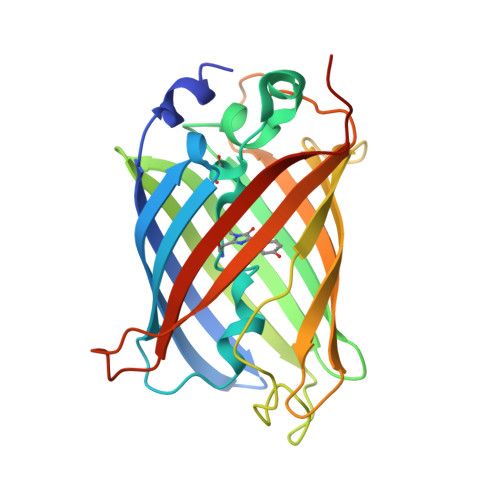Hidden photoinduced reactivity of the blue fluorescent protein mKalama1.
Vegh, R.B., Bloch, D.A., Bommarius, A.S., Verkhovsky, M., Pletnev, S., Iwai, H., Bochenkova, A.V., Solntsev, K.M.(2015) Phys Chem Chem Phys 17: 12472-12485
- PubMed: 25805012
- DOI: https://doi.org/10.1039/c5cp00887e
- Primary Citation of Related Structures:
4ORN - PubMed Abstract:
Understanding the photoinduced dynamics of fluorescent proteins is essential for their applications in bioimaging. Despite numerous studies on the ultrafast dynamics, the delayed response of these proteins, which often results in population of kinetically trapped dark states of various origins, is largely unexplored. Here, by using transient absorption spectroscopy spanning the time scale from picoseconds to seconds, we reveal a hidden reactivity of the bright blue-light emitting protein mKalama1 previously thought to be inert. This protein shows no excited-state proton transfer during its nanosecond excited-state lifetime; however, its tyrosine-based chromophore undergoes deprotonation coupled to non-radiative electronic relaxation. Such deprotonation causes distinct optical absorption changes in the broad UV-to-NIR spectral range (ca. 300-800 nm); the disappearance of the transient absorption signal has a complex nature and spans the whole microsecond-to-second time scale. The mechanisms underlying the relaxation kinetics are disclosed based on the X-ray structural analysis of mKalama1 and the high-level electronic structure calculations of proposed intermediates in the photocycle. We conclude that the non-radiative excited-state decay includes two major branches: internal conversion coupled to intraprotein proton transfer, where a conserved residue E222 serves as the proton acceptor; and ionization induced by two consecutive resonant absorption events, followed by deprotonation of the chromophore radical cation to bulk solvent through a novel water-mediated proton-wire pathway. Our findings open up new perspectives on the dynamics of fluorescent proteins as tracked by its optical transient absorption in the time domain extending up to seconds.
Organizational Affiliation:
School of Chemistry and Biochemistry, Georgia Institute of Technology, Atlanta, Georgia 30332, USA. solntsev@gatech.edu.



















